Cyber Security: Analyzing Threats, Mitigation Strategies, and Warfare
VerifiedAdded on 2023/04/21
|29
|8168
|290
Report
AI Summary
This report provides an in-depth analysis of cyber security, focusing on threats, mitigation strategies, and cyberwarfare. It begins with an introduction to cyber security, highlighting its increasing importance due to the proliferation of internet-connected devices and the associated security concerns. The research objectives include understanding cyberwarfare mitigation and the basic elements of cyber security. The literature review defines cyberwarfare and discusses elements such as application security, information security, network security, disaster recovery, and operational security. It also presents cases of cyber warfare, including Aurora 2010, Stuxnet, and Flame. The discussion chapter explores various types of security risks like ransomware, malware, social engineering, phishing, and other cyber-attacks, including Man-in-the-Middle attacks, SQL injection, Zero-Day Exploits, and Denial-of-service attacks. The report concludes with recommendations for mitigating these threats and enhancing overall cyber security.
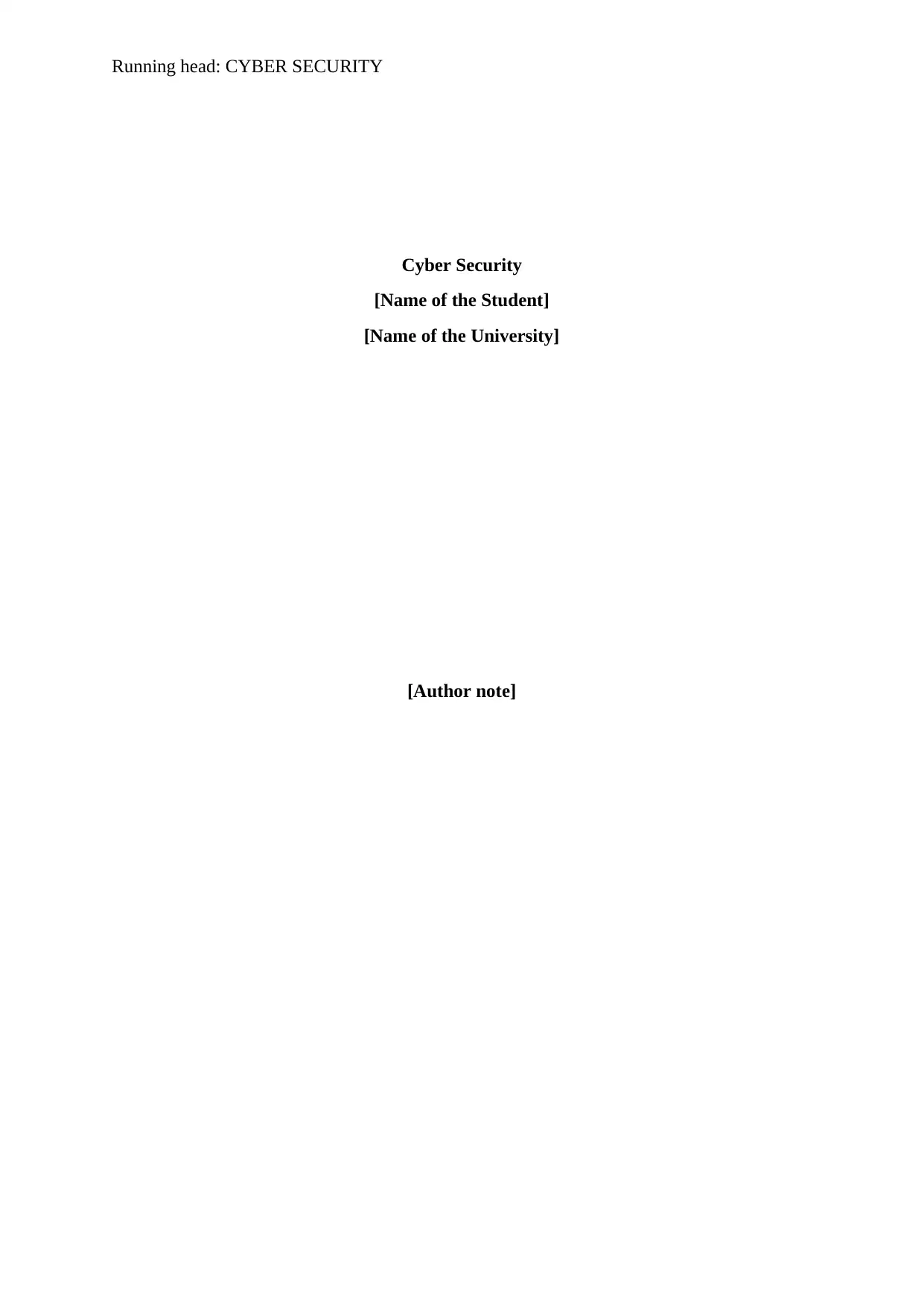
Running head: CYBER SECURITY
Cyber Security
[Name of the Student]
[Name of the University]
[Author note]
Cyber Security
[Name of the Student]
[Name of the University]
[Author note]
Paraphrase This Document
Need a fresh take? Get an instant paraphrase of this document with our AI Paraphraser
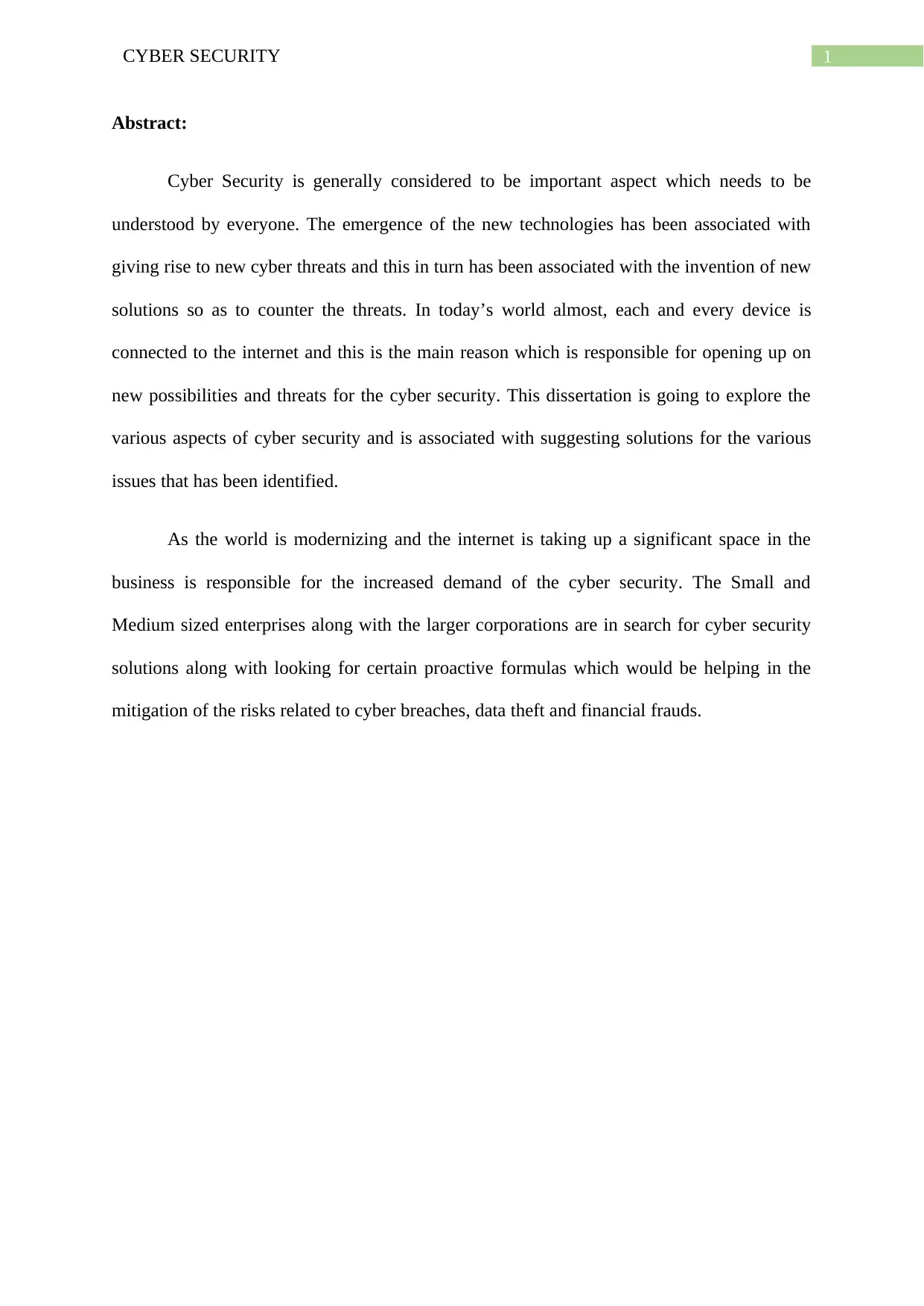
1CYBER SECURITY
Abstract:
Cyber Security is generally considered to be important aspect which needs to be
understood by everyone. The emergence of the new technologies has been associated with
giving rise to new cyber threats and this in turn has been associated with the invention of new
solutions so as to counter the threats. In today’s world almost, each and every device is
connected to the internet and this is the main reason which is responsible for opening up on
new possibilities and threats for the cyber security. This dissertation is going to explore the
various aspects of cyber security and is associated with suggesting solutions for the various
issues that has been identified.
As the world is modernizing and the internet is taking up a significant space in the
business is responsible for the increased demand of the cyber security. The Small and
Medium sized enterprises along with the larger corporations are in search for cyber security
solutions along with looking for certain proactive formulas which would be helping in the
mitigation of the risks related to cyber breaches, data theft and financial frauds.
Abstract:
Cyber Security is generally considered to be important aspect which needs to be
understood by everyone. The emergence of the new technologies has been associated with
giving rise to new cyber threats and this in turn has been associated with the invention of new
solutions so as to counter the threats. In today’s world almost, each and every device is
connected to the internet and this is the main reason which is responsible for opening up on
new possibilities and threats for the cyber security. This dissertation is going to explore the
various aspects of cyber security and is associated with suggesting solutions for the various
issues that has been identified.
As the world is modernizing and the internet is taking up a significant space in the
business is responsible for the increased demand of the cyber security. The Small and
Medium sized enterprises along with the larger corporations are in search for cyber security
solutions along with looking for certain proactive formulas which would be helping in the
mitigation of the risks related to cyber breaches, data theft and financial frauds.
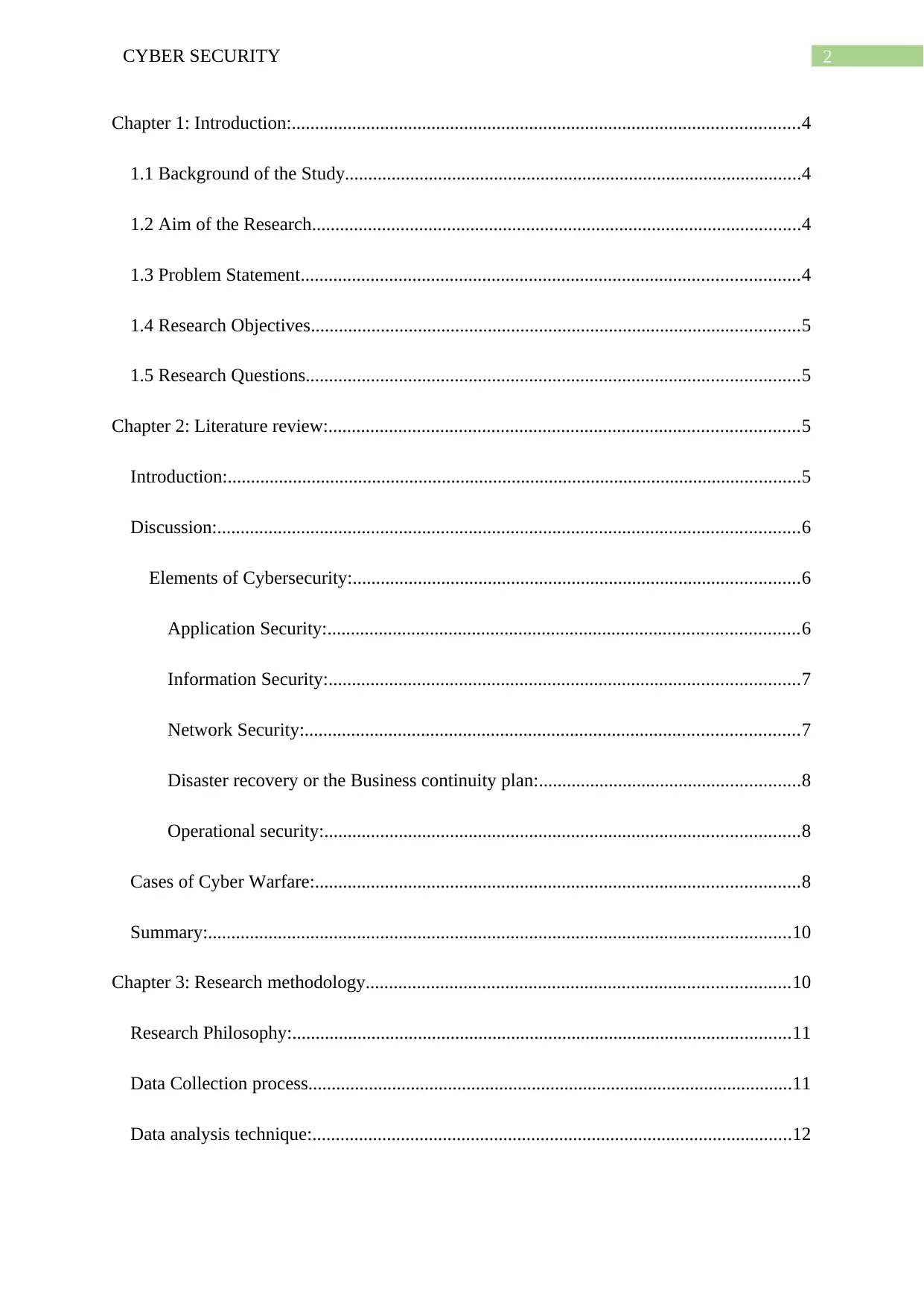
2CYBER SECURITY
Chapter 1: Introduction:.............................................................................................................4
1.1 Background of the Study..................................................................................................4
1.2 Aim of the Research.........................................................................................................4
1.3 Problem Statement...........................................................................................................4
1.4 Research Objectives.........................................................................................................5
1.5 Research Questions..........................................................................................................5
Chapter 2: Literature review:.....................................................................................................5
Introduction:...........................................................................................................................5
Discussion:.............................................................................................................................6
Elements of Cybersecurity:................................................................................................6
Application Security:.....................................................................................................6
Information Security:.....................................................................................................7
Network Security:..........................................................................................................7
Disaster recovery or the Business continuity plan:........................................................8
Operational security:......................................................................................................8
Cases of Cyber Warfare:........................................................................................................8
Summary:.............................................................................................................................10
Chapter 3: Research methodology...........................................................................................10
Research Philosophy:...........................................................................................................11
Data Collection process........................................................................................................11
Data analysis technique:.......................................................................................................12
Chapter 1: Introduction:.............................................................................................................4
1.1 Background of the Study..................................................................................................4
1.2 Aim of the Research.........................................................................................................4
1.3 Problem Statement...........................................................................................................4
1.4 Research Objectives.........................................................................................................5
1.5 Research Questions..........................................................................................................5
Chapter 2: Literature review:.....................................................................................................5
Introduction:...........................................................................................................................5
Discussion:.............................................................................................................................6
Elements of Cybersecurity:................................................................................................6
Application Security:.....................................................................................................6
Information Security:.....................................................................................................7
Network Security:..........................................................................................................7
Disaster recovery or the Business continuity plan:........................................................8
Operational security:......................................................................................................8
Cases of Cyber Warfare:........................................................................................................8
Summary:.............................................................................................................................10
Chapter 3: Research methodology...........................................................................................10
Research Philosophy:...........................................................................................................11
Data Collection process........................................................................................................11
Data analysis technique:.......................................................................................................12
⊘ This is a preview!⊘
Do you want full access?
Subscribe today to unlock all pages.

Trusted by 1+ million students worldwide
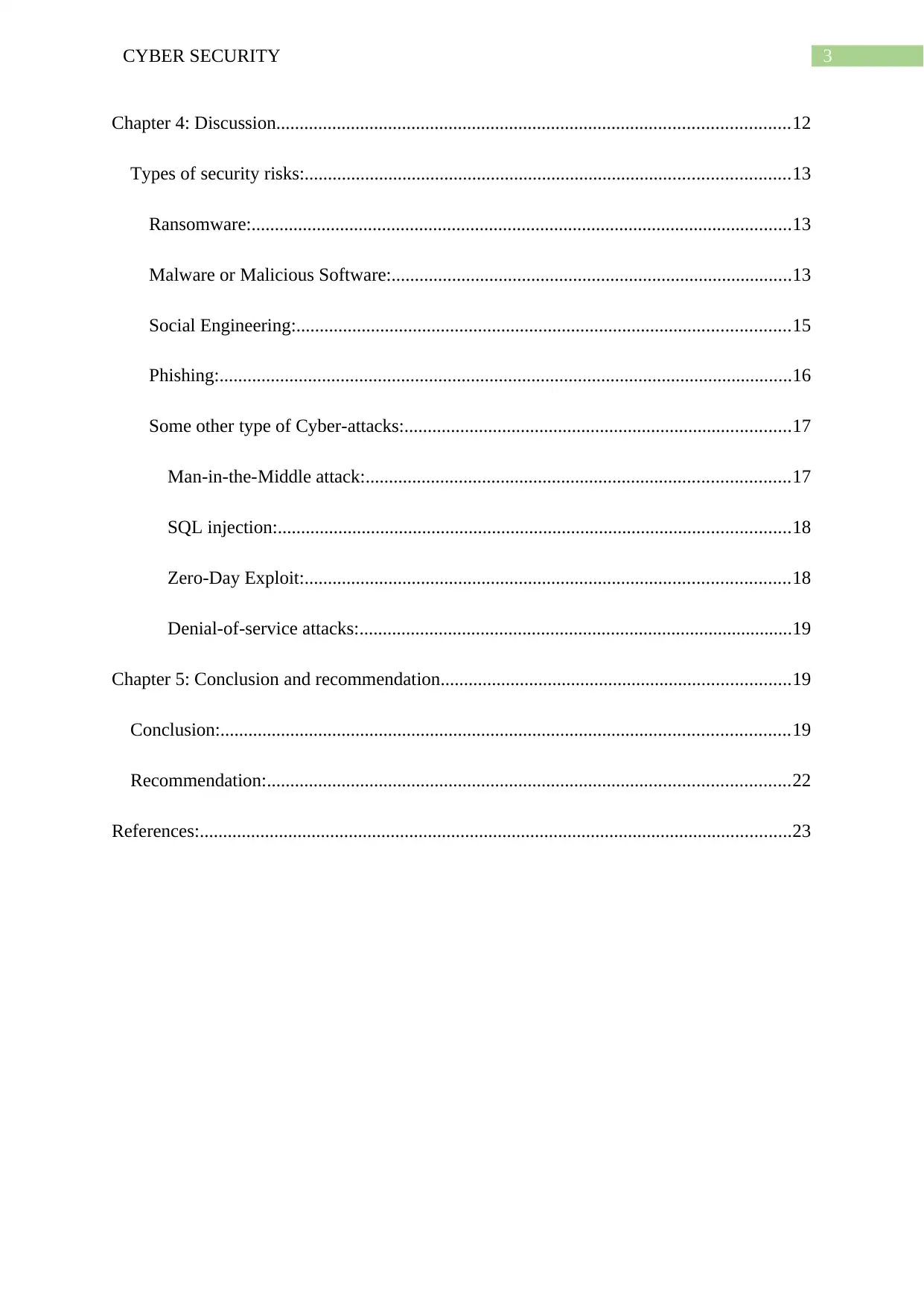
3CYBER SECURITY
Chapter 4: Discussion..............................................................................................................12
Types of security risks:........................................................................................................13
Ransomware:....................................................................................................................13
Malware or Malicious Software:......................................................................................13
Social Engineering:..........................................................................................................15
Phishing:...........................................................................................................................16
Some other type of Cyber-attacks:...................................................................................17
Man-in-the-Middle attack:...........................................................................................17
SQL injection:..............................................................................................................18
Zero-Day Exploit:........................................................................................................18
Denial-of-service attacks:.............................................................................................19
Chapter 5: Conclusion and recommendation...........................................................................19
Conclusion:..........................................................................................................................19
Recommendation:................................................................................................................22
References:...............................................................................................................................23
Chapter 4: Discussion..............................................................................................................12
Types of security risks:........................................................................................................13
Ransomware:....................................................................................................................13
Malware or Malicious Software:......................................................................................13
Social Engineering:..........................................................................................................15
Phishing:...........................................................................................................................16
Some other type of Cyber-attacks:...................................................................................17
Man-in-the-Middle attack:...........................................................................................17
SQL injection:..............................................................................................................18
Zero-Day Exploit:........................................................................................................18
Denial-of-service attacks:.............................................................................................19
Chapter 5: Conclusion and recommendation...........................................................................19
Conclusion:..........................................................................................................................19
Recommendation:................................................................................................................22
References:...............................................................................................................................23
Paraphrase This Document
Need a fresh take? Get an instant paraphrase of this document with our AI Paraphraser
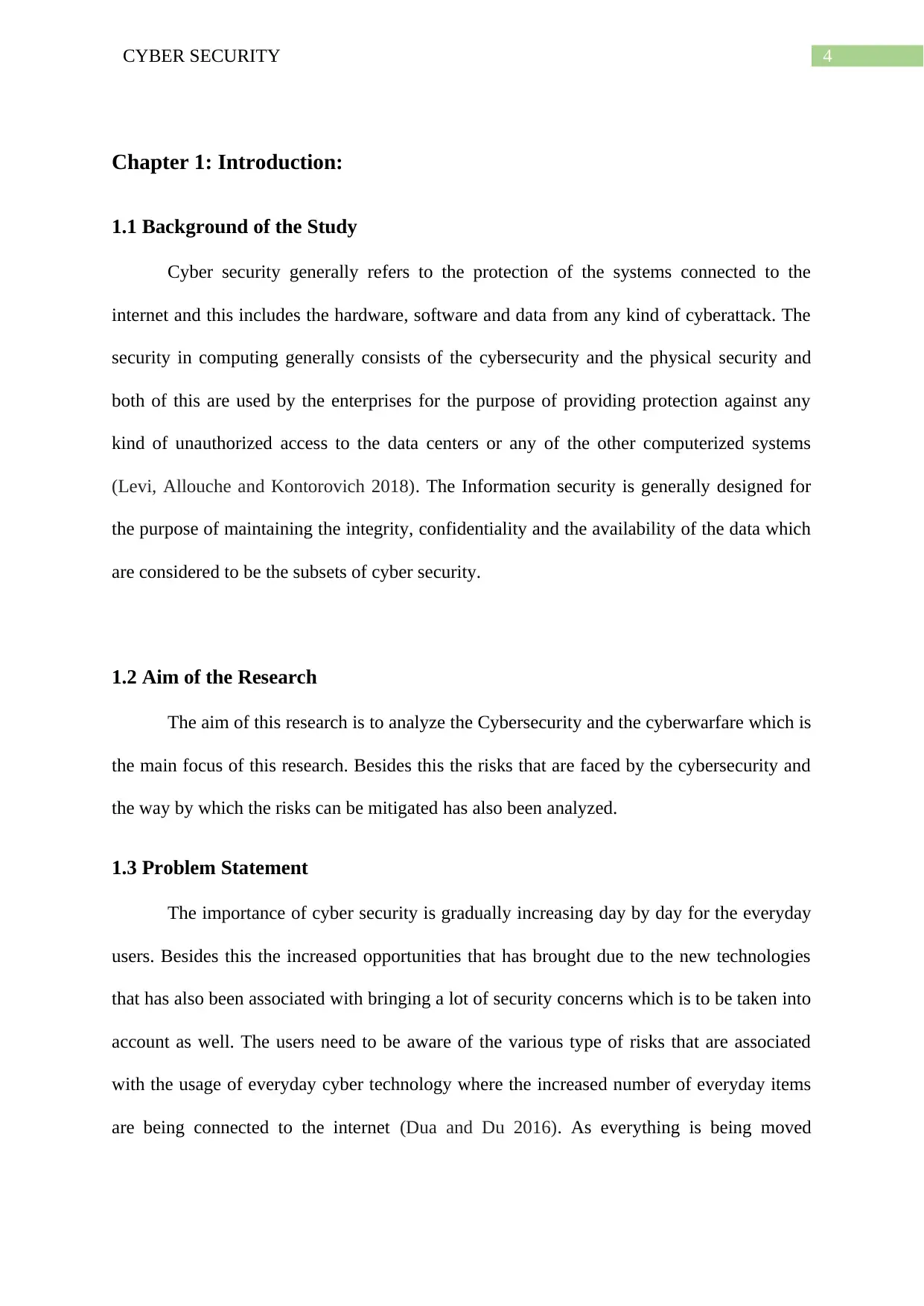
4CYBER SECURITY
Chapter 1: Introduction:
1.1 Background of the Study
Cyber security generally refers to the protection of the systems connected to the
internet and this includes the hardware, software and data from any kind of cyberattack. The
security in computing generally consists of the cybersecurity and the physical security and
both of this are used by the enterprises for the purpose of providing protection against any
kind of unauthorized access to the data centers or any of the other computerized systems
(Levi, Allouche and Kontorovich 2018). The Information security is generally designed for
the purpose of maintaining the integrity, confidentiality and the availability of the data which
are considered to be the subsets of cyber security.
1.2 Aim of the Research
The aim of this research is to analyze the Cybersecurity and the cyberwarfare which is
the main focus of this research. Besides this the risks that are faced by the cybersecurity and
the way by which the risks can be mitigated has also been analyzed.
1.3 Problem Statement
The importance of cyber security is gradually increasing day by day for the everyday
users. Besides this the increased opportunities that has brought due to the new technologies
that has also been associated with bringing a lot of security concerns which is to be taken into
account as well. The users need to be aware of the various type of risks that are associated
with the usage of everyday cyber technology where the increased number of everyday items
are being connected to the internet (Dua and Du 2016). As everything is being moved
Chapter 1: Introduction:
1.1 Background of the Study
Cyber security generally refers to the protection of the systems connected to the
internet and this includes the hardware, software and data from any kind of cyberattack. The
security in computing generally consists of the cybersecurity and the physical security and
both of this are used by the enterprises for the purpose of providing protection against any
kind of unauthorized access to the data centers or any of the other computerized systems
(Levi, Allouche and Kontorovich 2018). The Information security is generally designed for
the purpose of maintaining the integrity, confidentiality and the availability of the data which
are considered to be the subsets of cyber security.
1.2 Aim of the Research
The aim of this research is to analyze the Cybersecurity and the cyberwarfare which is
the main focus of this research. Besides this the risks that are faced by the cybersecurity and
the way by which the risks can be mitigated has also been analyzed.
1.3 Problem Statement
The importance of cyber security is gradually increasing day by day for the everyday
users. Besides this the increased opportunities that has brought due to the new technologies
that has also been associated with bringing a lot of security concerns which is to be taken into
account as well. The users need to be aware of the various type of risks that are associated
with the usage of everyday cyber technology where the increased number of everyday items
are being connected to the internet (Dua and Du 2016). As everything is being moved
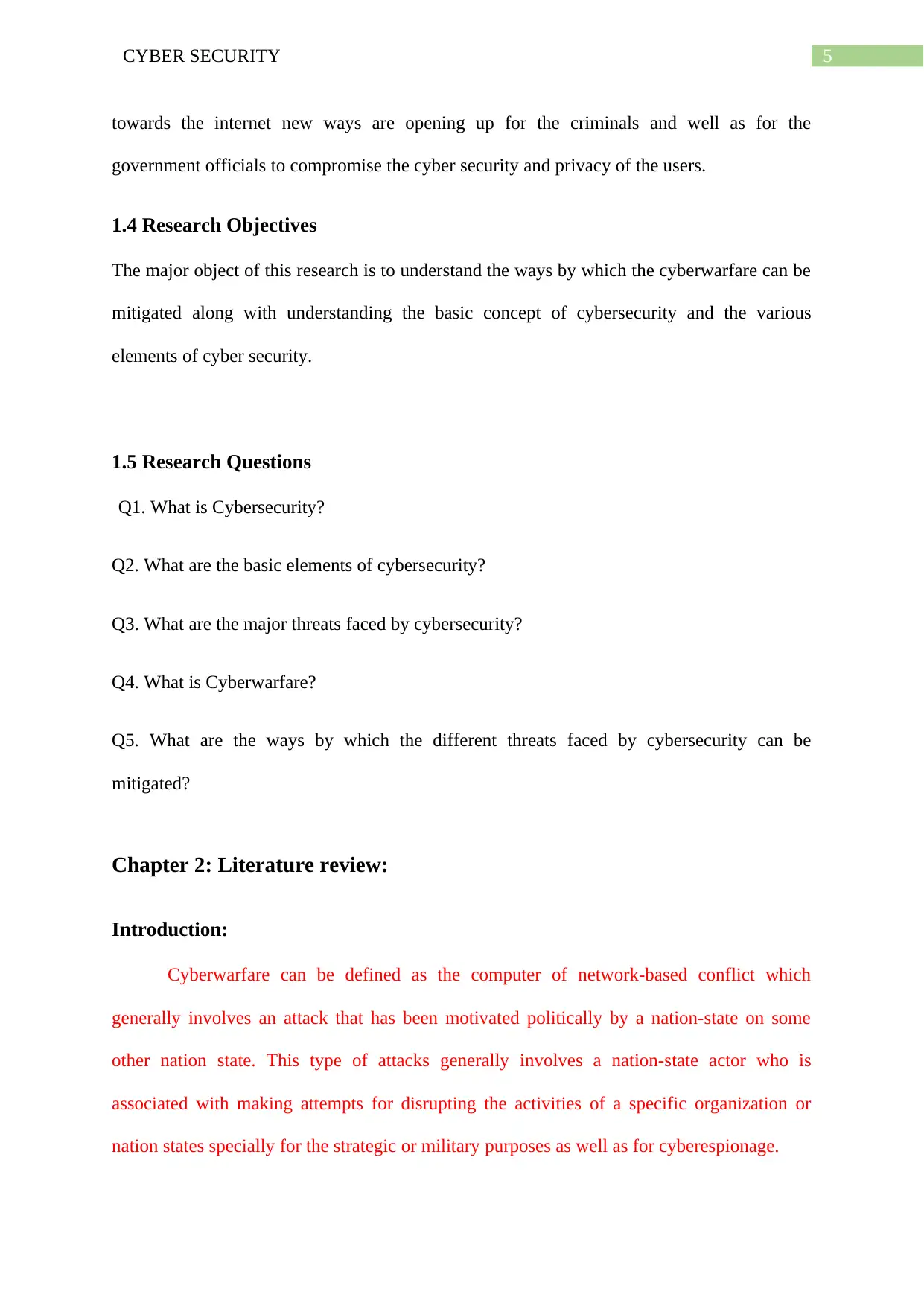
5CYBER SECURITY
towards the internet new ways are opening up for the criminals and well as for the
government officials to compromise the cyber security and privacy of the users.
1.4 Research Objectives
The major object of this research is to understand the ways by which the cyberwarfare can be
mitigated along with understanding the basic concept of cybersecurity and the various
elements of cyber security.
1.5 Research Questions
Q1. What is Cybersecurity?
Q2. What are the basic elements of cybersecurity?
Q3. What are the major threats faced by cybersecurity?
Q4. What is Cyberwarfare?
Q5. What are the ways by which the different threats faced by cybersecurity can be
mitigated?
Chapter 2: Literature review:
Introduction:
Cyberwarfare can be defined as the computer of network-based conflict which
generally involves an attack that has been motivated politically by a nation-state on some
other nation state. This type of attacks generally involves a nation-state actor who is
associated with making attempts for disrupting the activities of a specific organization or
nation states specially for the strategic or military purposes as well as for cyberespionage.
towards the internet new ways are opening up for the criminals and well as for the
government officials to compromise the cyber security and privacy of the users.
1.4 Research Objectives
The major object of this research is to understand the ways by which the cyberwarfare can be
mitigated along with understanding the basic concept of cybersecurity and the various
elements of cyber security.
1.5 Research Questions
Q1. What is Cybersecurity?
Q2. What are the basic elements of cybersecurity?
Q3. What are the major threats faced by cybersecurity?
Q4. What is Cyberwarfare?
Q5. What are the ways by which the different threats faced by cybersecurity can be
mitigated?
Chapter 2: Literature review:
Introduction:
Cyberwarfare can be defined as the computer of network-based conflict which
generally involves an attack that has been motivated politically by a nation-state on some
other nation state. This type of attacks generally involves a nation-state actor who is
associated with making attempts for disrupting the activities of a specific organization or
nation states specially for the strategic or military purposes as well as for cyberespionage.
⊘ This is a preview!⊘
Do you want full access?
Subscribe today to unlock all pages.

Trusted by 1+ million students worldwide
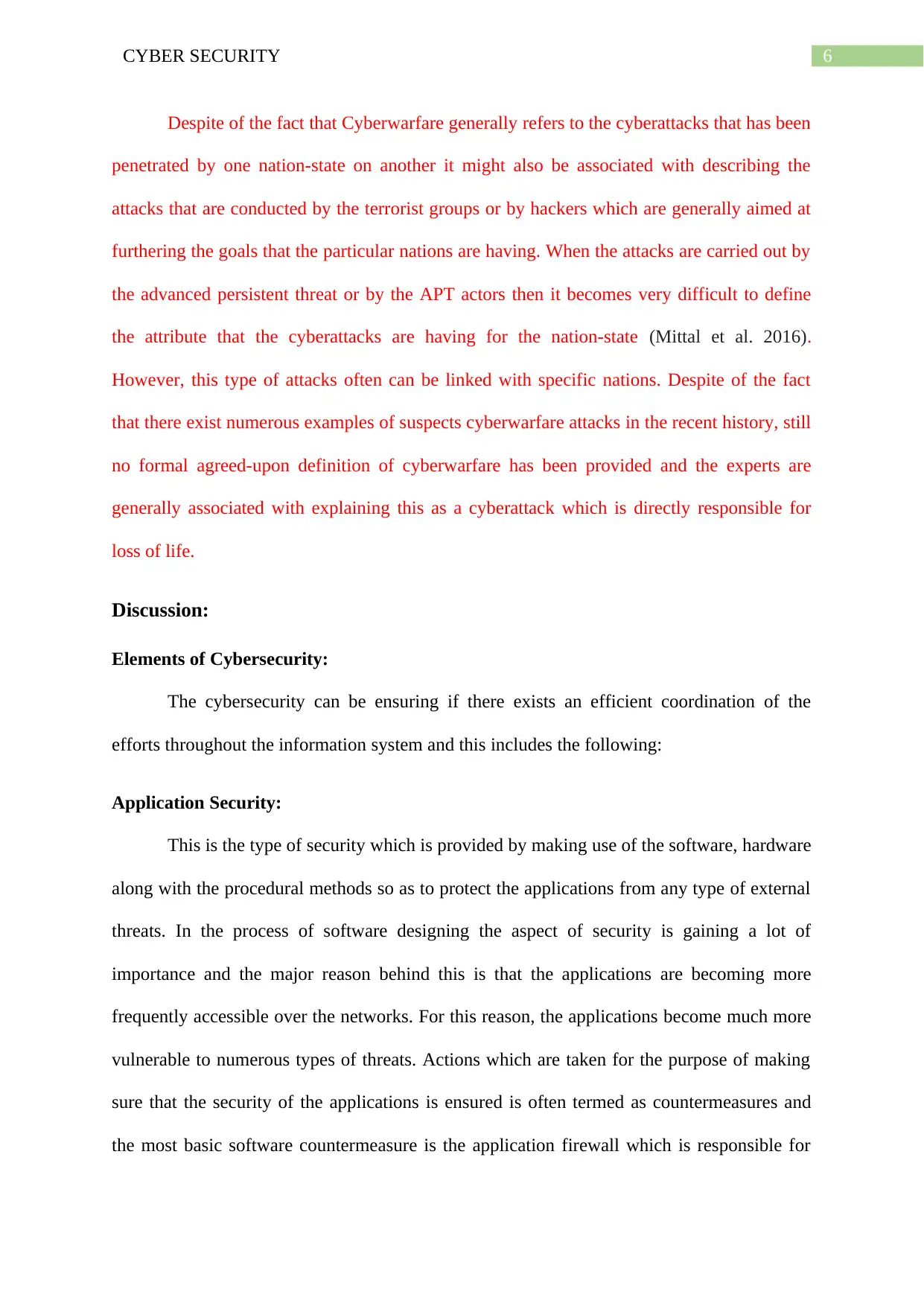
6CYBER SECURITY
Despite of the fact that Cyberwarfare generally refers to the cyberattacks that has been
penetrated by one nation-state on another it might also be associated with describing the
attacks that are conducted by the terrorist groups or by hackers which are generally aimed at
furthering the goals that the particular nations are having. When the attacks are carried out by
the advanced persistent threat or by the APT actors then it becomes very difficult to define
the attribute that the cyberattacks are having for the nation-state (Mittal et al. 2016).
However, this type of attacks often can be linked with specific nations. Despite of the fact
that there exist numerous examples of suspects cyberwarfare attacks in the recent history, still
no formal agreed-upon definition of cyberwarfare has been provided and the experts are
generally associated with explaining this as a cyberattack which is directly responsible for
loss of life.
Discussion:
Elements of Cybersecurity:
The cybersecurity can be ensuring if there exists an efficient coordination of the
efforts throughout the information system and this includes the following:
Application Security:
This is the type of security which is provided by making use of the software, hardware
along with the procedural methods so as to protect the applications from any type of external
threats. In the process of software designing the aspect of security is gaining a lot of
importance and the major reason behind this is that the applications are becoming more
frequently accessible over the networks. For this reason, the applications become much more
vulnerable to numerous types of threats. Actions which are taken for the purpose of making
sure that the security of the applications is ensured is often termed as countermeasures and
the most basic software countermeasure is the application firewall which is responsible for
Despite of the fact that Cyberwarfare generally refers to the cyberattacks that has been
penetrated by one nation-state on another it might also be associated with describing the
attacks that are conducted by the terrorist groups or by hackers which are generally aimed at
furthering the goals that the particular nations are having. When the attacks are carried out by
the advanced persistent threat or by the APT actors then it becomes very difficult to define
the attribute that the cyberattacks are having for the nation-state (Mittal et al. 2016).
However, this type of attacks often can be linked with specific nations. Despite of the fact
that there exist numerous examples of suspects cyberwarfare attacks in the recent history, still
no formal agreed-upon definition of cyberwarfare has been provided and the experts are
generally associated with explaining this as a cyberattack which is directly responsible for
loss of life.
Discussion:
Elements of Cybersecurity:
The cybersecurity can be ensuring if there exists an efficient coordination of the
efforts throughout the information system and this includes the following:
Application Security:
This is the type of security which is provided by making use of the software, hardware
along with the procedural methods so as to protect the applications from any type of external
threats. In the process of software designing the aspect of security is gaining a lot of
importance and the major reason behind this is that the applications are becoming more
frequently accessible over the networks. For this reason, the applications become much more
vulnerable to numerous types of threats. Actions which are taken for the purpose of making
sure that the security of the applications is ensured is often termed as countermeasures and
the most basic software countermeasure is the application firewall which is responsible for
Paraphrase This Document
Need a fresh take? Get an instant paraphrase of this document with our AI Paraphraser
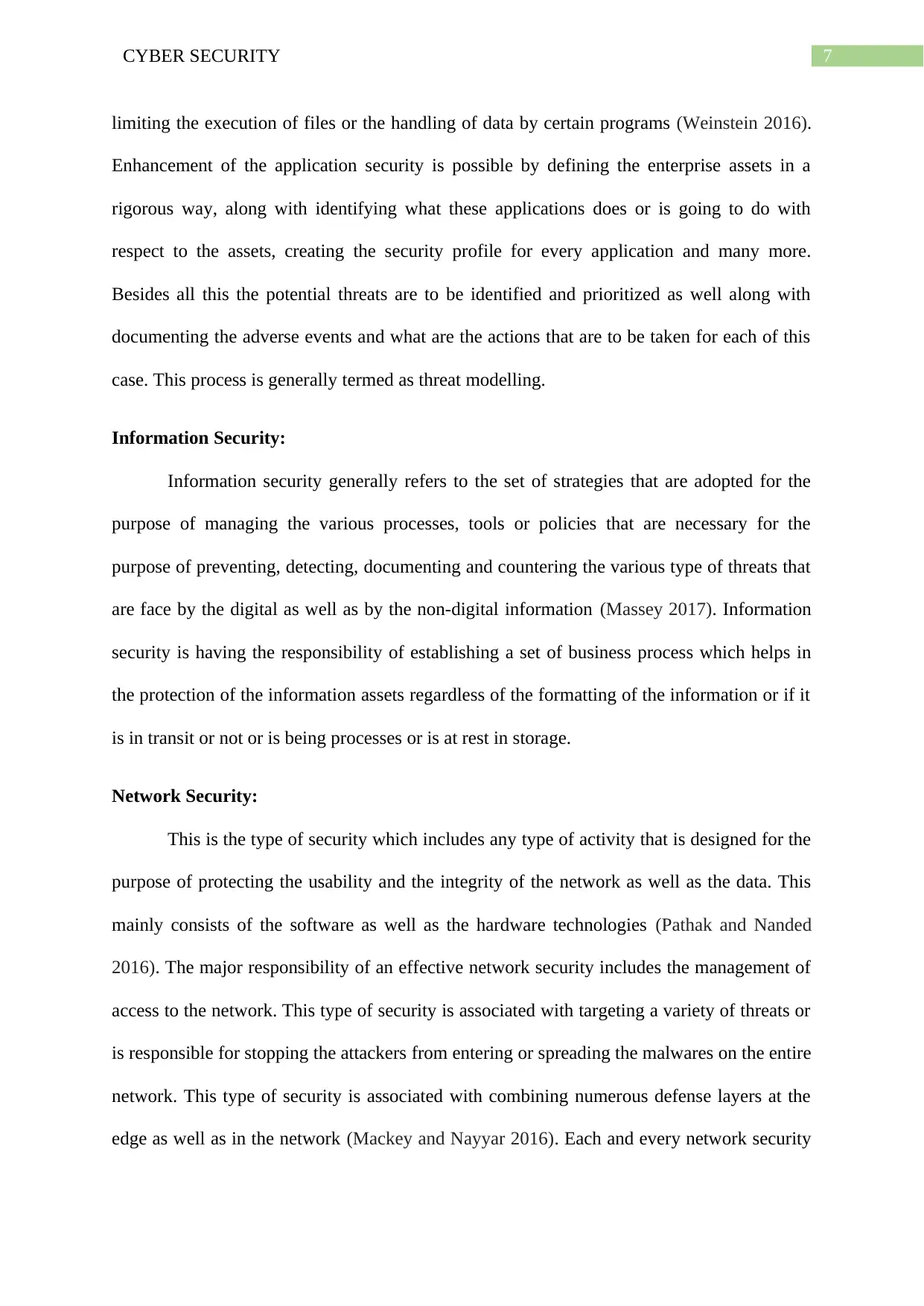
7CYBER SECURITY
limiting the execution of files or the handling of data by certain programs (Weinstein 2016).
Enhancement of the application security is possible by defining the enterprise assets in a
rigorous way, along with identifying what these applications does or is going to do with
respect to the assets, creating the security profile for every application and many more.
Besides all this the potential threats are to be identified and prioritized as well along with
documenting the adverse events and what are the actions that are to be taken for each of this
case. This process is generally termed as threat modelling.
Information Security:
Information security generally refers to the set of strategies that are adopted for the
purpose of managing the various processes, tools or policies that are necessary for the
purpose of preventing, detecting, documenting and countering the various type of threats that
are face by the digital as well as by the non-digital information (Massey 2017). Information
security is having the responsibility of establishing a set of business process which helps in
the protection of the information assets regardless of the formatting of the information or if it
is in transit or not or is being processes or is at rest in storage.
Network Security:
This is the type of security which includes any type of activity that is designed for the
purpose of protecting the usability and the integrity of the network as well as the data. This
mainly consists of the software as well as the hardware technologies (Pathak and Nanded
2016). The major responsibility of an effective network security includes the management of
access to the network. This type of security is associated with targeting a variety of threats or
is responsible for stopping the attackers from entering or spreading the malwares on the entire
network. This type of security is associated with combining numerous defense layers at the
edge as well as in the network (Mackey and Nayyar 2016). Each and every network security
limiting the execution of files or the handling of data by certain programs (Weinstein 2016).
Enhancement of the application security is possible by defining the enterprise assets in a
rigorous way, along with identifying what these applications does or is going to do with
respect to the assets, creating the security profile for every application and many more.
Besides all this the potential threats are to be identified and prioritized as well along with
documenting the adverse events and what are the actions that are to be taken for each of this
case. This process is generally termed as threat modelling.
Information Security:
Information security generally refers to the set of strategies that are adopted for the
purpose of managing the various processes, tools or policies that are necessary for the
purpose of preventing, detecting, documenting and countering the various type of threats that
are face by the digital as well as by the non-digital information (Massey 2017). Information
security is having the responsibility of establishing a set of business process which helps in
the protection of the information assets regardless of the formatting of the information or if it
is in transit or not or is being processes or is at rest in storage.
Network Security:
This is the type of security which includes any type of activity that is designed for the
purpose of protecting the usability and the integrity of the network as well as the data. This
mainly consists of the software as well as the hardware technologies (Pathak and Nanded
2016). The major responsibility of an effective network security includes the management of
access to the network. This type of security is associated with targeting a variety of threats or
is responsible for stopping the attackers from entering or spreading the malwares on the entire
network. This type of security is associated with combining numerous defense layers at the
edge as well as in the network (Mackey and Nayyar 2016). Each and every network security
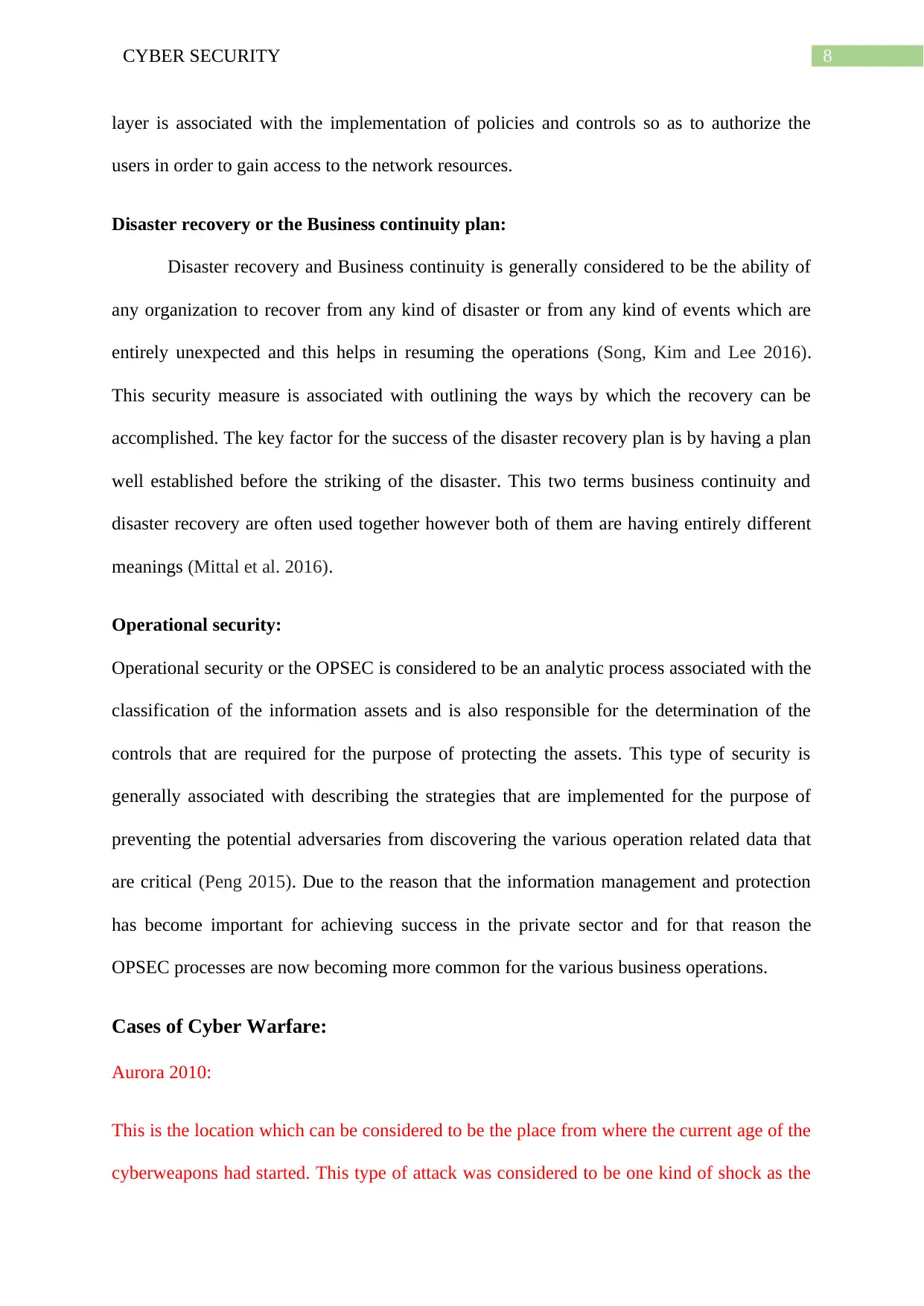
8CYBER SECURITY
layer is associated with the implementation of policies and controls so as to authorize the
users in order to gain access to the network resources.
Disaster recovery or the Business continuity plan:
Disaster recovery and Business continuity is generally considered to be the ability of
any organization to recover from any kind of disaster or from any kind of events which are
entirely unexpected and this helps in resuming the operations (Song, Kim and Lee 2016).
This security measure is associated with outlining the ways by which the recovery can be
accomplished. The key factor for the success of the disaster recovery plan is by having a plan
well established before the striking of the disaster. This two terms business continuity and
disaster recovery are often used together however both of them are having entirely different
meanings (Mittal et al. 2016).
Operational security:
Operational security or the OPSEC is considered to be an analytic process associated with the
classification of the information assets and is also responsible for the determination of the
controls that are required for the purpose of protecting the assets. This type of security is
generally associated with describing the strategies that are implemented for the purpose of
preventing the potential adversaries from discovering the various operation related data that
are critical (Peng 2015). Due to the reason that the information management and protection
has become important for achieving success in the private sector and for that reason the
OPSEC processes are now becoming more common for the various business operations.
Cases of Cyber Warfare:
Aurora 2010:
This is the location which can be considered to be the place from where the current age of the
cyberweapons had started. This type of attack was considered to be one kind of shock as the
layer is associated with the implementation of policies and controls so as to authorize the
users in order to gain access to the network resources.
Disaster recovery or the Business continuity plan:
Disaster recovery and Business continuity is generally considered to be the ability of
any organization to recover from any kind of disaster or from any kind of events which are
entirely unexpected and this helps in resuming the operations (Song, Kim and Lee 2016).
This security measure is associated with outlining the ways by which the recovery can be
accomplished. The key factor for the success of the disaster recovery plan is by having a plan
well established before the striking of the disaster. This two terms business continuity and
disaster recovery are often used together however both of them are having entirely different
meanings (Mittal et al. 2016).
Operational security:
Operational security or the OPSEC is considered to be an analytic process associated with the
classification of the information assets and is also responsible for the determination of the
controls that are required for the purpose of protecting the assets. This type of security is
generally associated with describing the strategies that are implemented for the purpose of
preventing the potential adversaries from discovering the various operation related data that
are critical (Peng 2015). Due to the reason that the information management and protection
has become important for achieving success in the private sector and for that reason the
OPSEC processes are now becoming more common for the various business operations.
Cases of Cyber Warfare:
Aurora 2010:
This is the location which can be considered to be the place from where the current age of the
cyberweapons had started. This type of attack was considered to be one kind of shock as the
⊘ This is a preview!⊘
Do you want full access?
Subscribe today to unlock all pages.

Trusted by 1+ million students worldwide
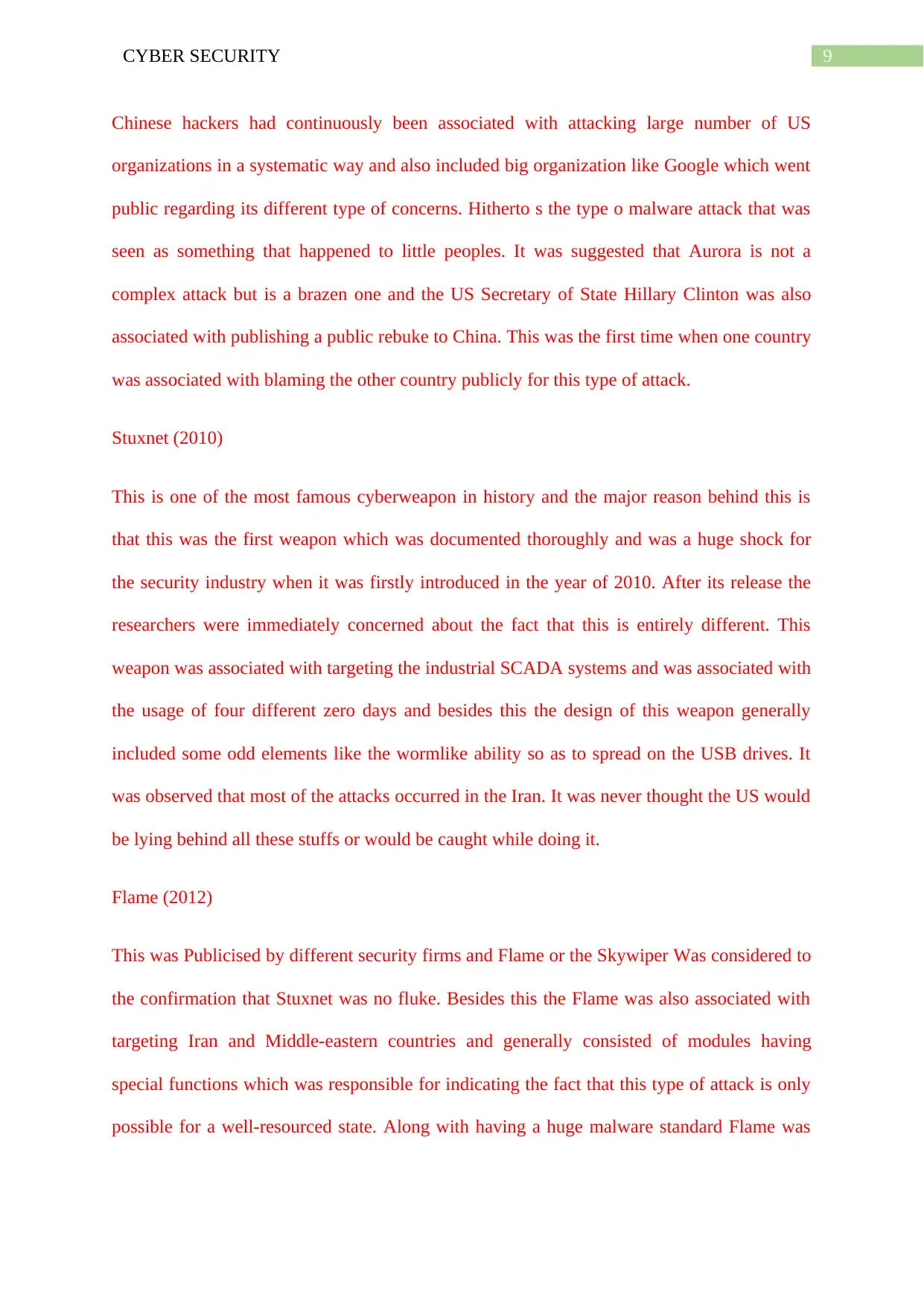
9CYBER SECURITY
Chinese hackers had continuously been associated with attacking large number of US
organizations in a systematic way and also included big organization like Google which went
public regarding its different type of concerns. Hitherto s the type o malware attack that was
seen as something that happened to little peoples. It was suggested that Aurora is not a
complex attack but is a brazen one and the US Secretary of State Hillary Clinton was also
associated with publishing a public rebuke to China. This was the first time when one country
was associated with blaming the other country publicly for this type of attack.
Stuxnet (2010)
This is one of the most famous cyberweapon in history and the major reason behind this is
that this was the first weapon which was documented thoroughly and was a huge shock for
the security industry when it was firstly introduced in the year of 2010. After its release the
researchers were immediately concerned about the fact that this is entirely different. This
weapon was associated with targeting the industrial SCADA systems and was associated with
the usage of four different zero days and besides this the design of this weapon generally
included some odd elements like the wormlike ability so as to spread on the USB drives. It
was observed that most of the attacks occurred in the Iran. It was never thought the US would
be lying behind all these stuffs or would be caught while doing it.
Flame (2012)
This was Publicised by different security firms and Flame or the Skywiper Was considered to
the confirmation that Stuxnet was no fluke. Besides this the Flame was also associated with
targeting Iran and Middle-eastern countries and generally consisted of modules having
special functions which was responsible for indicating the fact that this type of attack is only
possible for a well-resourced state. Along with having a huge malware standard Flame was
Chinese hackers had continuously been associated with attacking large number of US
organizations in a systematic way and also included big organization like Google which went
public regarding its different type of concerns. Hitherto s the type o malware attack that was
seen as something that happened to little peoples. It was suggested that Aurora is not a
complex attack but is a brazen one and the US Secretary of State Hillary Clinton was also
associated with publishing a public rebuke to China. This was the first time when one country
was associated with blaming the other country publicly for this type of attack.
Stuxnet (2010)
This is one of the most famous cyberweapon in history and the major reason behind this is
that this was the first weapon which was documented thoroughly and was a huge shock for
the security industry when it was firstly introduced in the year of 2010. After its release the
researchers were immediately concerned about the fact that this is entirely different. This
weapon was associated with targeting the industrial SCADA systems and was associated with
the usage of four different zero days and besides this the design of this weapon generally
included some odd elements like the wormlike ability so as to spread on the USB drives. It
was observed that most of the attacks occurred in the Iran. It was never thought the US would
be lying behind all these stuffs or would be caught while doing it.
Flame (2012)
This was Publicised by different security firms and Flame or the Skywiper Was considered to
the confirmation that Stuxnet was no fluke. Besides this the Flame was also associated with
targeting Iran and Middle-eastern countries and generally consisted of modules having
special functions which was responsible for indicating the fact that this type of attack is only
possible for a well-resourced state. Along with having a huge malware standard Flame was
Paraphrase This Document
Need a fresh take? Get an instant paraphrase of this document with our AI Paraphraser
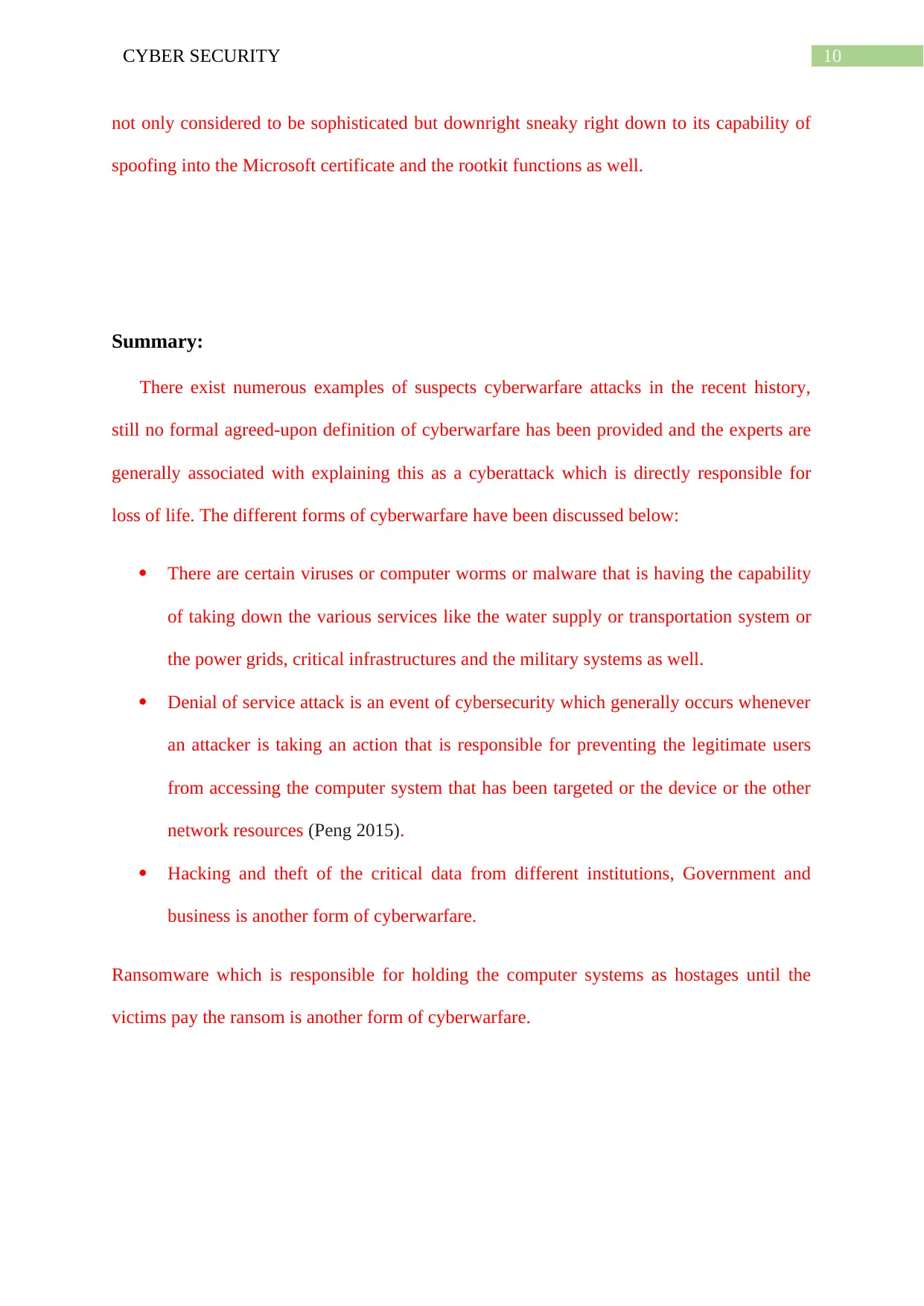
10CYBER SECURITY
not only considered to be sophisticated but downright sneaky right down to its capability of
spoofing into the Microsoft certificate and the rootkit functions as well.
Summary:
There exist numerous examples of suspects cyberwarfare attacks in the recent history,
still no formal agreed-upon definition of cyberwarfare has been provided and the experts are
generally associated with explaining this as a cyberattack which is directly responsible for
loss of life. The different forms of cyberwarfare have been discussed below:
There are certain viruses or computer worms or malware that is having the capability
of taking down the various services like the water supply or transportation system or
the power grids, critical infrastructures and the military systems as well.
Denial of service attack is an event of cybersecurity which generally occurs whenever
an attacker is taking an action that is responsible for preventing the legitimate users
from accessing the computer system that has been targeted or the device or the other
network resources (Peng 2015).
Hacking and theft of the critical data from different institutions, Government and
business is another form of cyberwarfare.
Ransomware which is responsible for holding the computer systems as hostages until the
victims pay the ransom is another form of cyberwarfare.
not only considered to be sophisticated but downright sneaky right down to its capability of
spoofing into the Microsoft certificate and the rootkit functions as well.
Summary:
There exist numerous examples of suspects cyberwarfare attacks in the recent history,
still no formal agreed-upon definition of cyberwarfare has been provided and the experts are
generally associated with explaining this as a cyberattack which is directly responsible for
loss of life. The different forms of cyberwarfare have been discussed below:
There are certain viruses or computer worms or malware that is having the capability
of taking down the various services like the water supply or transportation system or
the power grids, critical infrastructures and the military systems as well.
Denial of service attack is an event of cybersecurity which generally occurs whenever
an attacker is taking an action that is responsible for preventing the legitimate users
from accessing the computer system that has been targeted or the device or the other
network resources (Peng 2015).
Hacking and theft of the critical data from different institutions, Government and
business is another form of cyberwarfare.
Ransomware which is responsible for holding the computer systems as hostages until the
victims pay the ransom is another form of cyberwarfare.
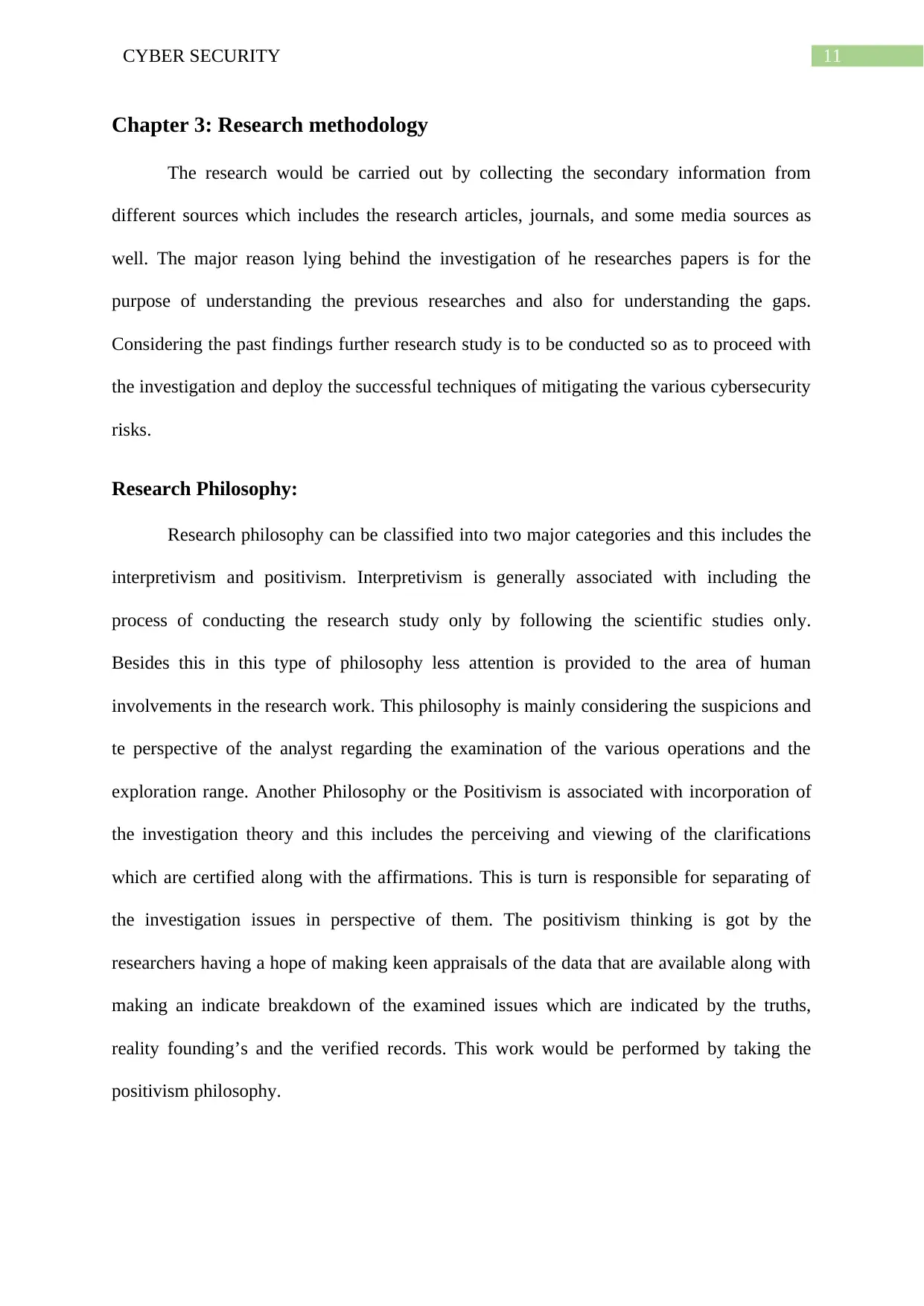
11CYBER SECURITY
Chapter 3: Research methodology
The research would be carried out by collecting the secondary information from
different sources which includes the research articles, journals, and some media sources as
well. The major reason lying behind the investigation of he researches papers is for the
purpose of understanding the previous researches and also for understanding the gaps.
Considering the past findings further research study is to be conducted so as to proceed with
the investigation and deploy the successful techniques of mitigating the various cybersecurity
risks.
Research Philosophy:
Research philosophy can be classified into two major categories and this includes the
interpretivism and positivism. Interpretivism is generally associated with including the
process of conducting the research study only by following the scientific studies only.
Besides this in this type of philosophy less attention is provided to the area of human
involvements in the research work. This philosophy is mainly considering the suspicions and
te perspective of the analyst regarding the examination of the various operations and the
exploration range. Another Philosophy or the Positivism is associated with incorporation of
the investigation theory and this includes the perceiving and viewing of the clarifications
which are certified along with the affirmations. This is turn is responsible for separating of
the investigation issues in perspective of them. The positivism thinking is got by the
researchers having a hope of making keen appraisals of the data that are available along with
making an indicate breakdown of the examined issues which are indicated by the truths,
reality founding’s and the verified records. This work would be performed by taking the
positivism philosophy.
Chapter 3: Research methodology
The research would be carried out by collecting the secondary information from
different sources which includes the research articles, journals, and some media sources as
well. The major reason lying behind the investigation of he researches papers is for the
purpose of understanding the previous researches and also for understanding the gaps.
Considering the past findings further research study is to be conducted so as to proceed with
the investigation and deploy the successful techniques of mitigating the various cybersecurity
risks.
Research Philosophy:
Research philosophy can be classified into two major categories and this includes the
interpretivism and positivism. Interpretivism is generally associated with including the
process of conducting the research study only by following the scientific studies only.
Besides this in this type of philosophy less attention is provided to the area of human
involvements in the research work. This philosophy is mainly considering the suspicions and
te perspective of the analyst regarding the examination of the various operations and the
exploration range. Another Philosophy or the Positivism is associated with incorporation of
the investigation theory and this includes the perceiving and viewing of the clarifications
which are certified along with the affirmations. This is turn is responsible for separating of
the investigation issues in perspective of them. The positivism thinking is got by the
researchers having a hope of making keen appraisals of the data that are available along with
making an indicate breakdown of the examined issues which are indicated by the truths,
reality founding’s and the verified records. This work would be performed by taking the
positivism philosophy.
⊘ This is a preview!⊘
Do you want full access?
Subscribe today to unlock all pages.

Trusted by 1+ million students worldwide
1 out of 29
Related Documents
Your All-in-One AI-Powered Toolkit for Academic Success.
+13062052269
info@desklib.com
Available 24*7 on WhatsApp / Email
![[object Object]](/_next/static/media/star-bottom.7253800d.svg)
Unlock your academic potential
Copyright © 2020–2025 A2Z Services. All Rights Reserved. Developed and managed by ZUCOL.





